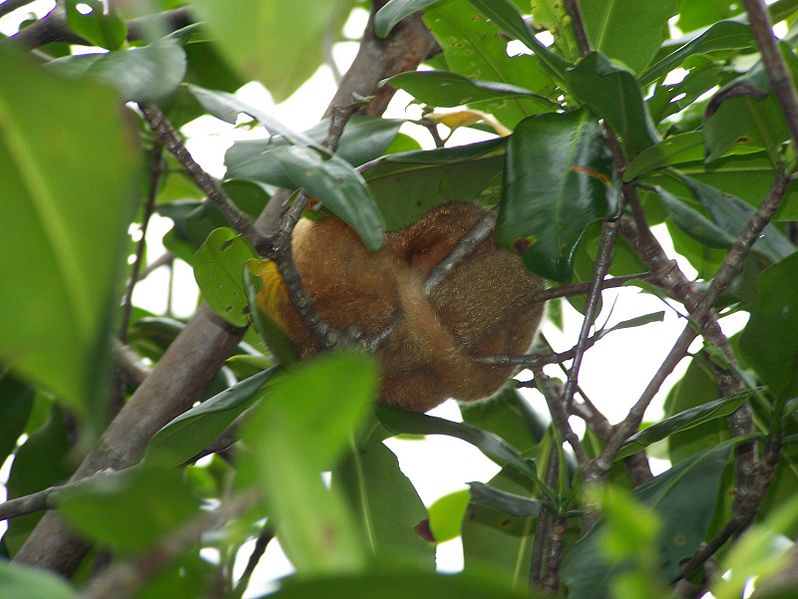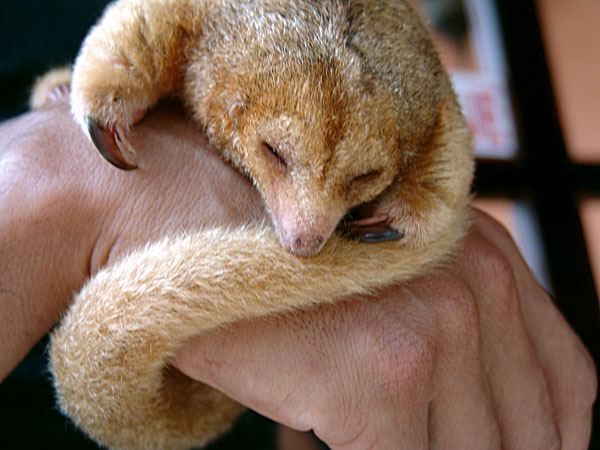How it Works
Cyclopes
didactylus is the smallest of the anteaters as it is
usually thirty five to forty five centimeters long including a
tail that is normally seventeen to twenty four centimeters long.
The tail of Cyclopes didactylus is naked on the
underside of it, which helps it grasp the branches as it moves
(EDGE of Existence 2014). It has an average weight between 175 grams to
400
 grams
and usually is a yellow color with a broad, dark stripe across
either its front or back (Hayssen et al 2012). Cyclopes didactylus resembles
the seed pods in the trees which provides excellent
(Schober 1999). This protection is needed due to its predators
having excellent vision. (Schober 1999) Their rib cage is made
up of broad flat ribs that interlock to form a solid armor
across their chest (Hayssen et al 2012). Cyclopes didactylus
has a total of five toes where two of them have claws. One of
the claws is present on the second toe and is very strong and
hook-like while the claw on the third toe is the same size, but
much more slender than the first (Hayssen et al 2012). The fourth toe
is small and has no claw while the other two toes are
vestigial or absent and not visible externally (Hayssen et al
2012).
The mouth of Cyclopes didactylus is long and tapered,
like the other anteaters (EDGE of Existence 2014). Their tong is long, has
spines on it, and is covered in sticky saliva to help catch the
ants and termites it eats (EDGE of Existence 2014).
grams
and usually is a yellow color with a broad, dark stripe across
either its front or back (Hayssen et al 2012). Cyclopes didactylus resembles
the seed pods in the trees which provides excellent
(Schober 1999). This protection is needed due to its predators
having excellent vision. (Schober 1999) Their rib cage is made
up of broad flat ribs that interlock to form a solid armor
across their chest (Hayssen et al 2012). Cyclopes didactylus
has a total of five toes where two of them have claws. One of
the claws is present on the second toe and is very strong and
hook-like while the claw on the third toe is the same size, but
much more slender than the first (Hayssen et al 2012). The fourth toe
is small and has no claw while the other two toes are
vestigial or absent and not visible externally (Hayssen et al
2012).
The mouth of Cyclopes didactylus is long and tapered,
like the other anteaters (EDGE of Existence 2014). Their tong is long, has
spines on it, and is covered in sticky saliva to help catch the
ants and termites it eats (EDGE of Existence 2014).
Cyclopes
didactylus is not normally an offensive animal as it is
very slow-moving (Schober 1999). However, when it gets
defensive, it curls its tail around the branch it is on and uses
it hind legs to grasp the branch (Schober 1999). Once it has
done this, it puts its front paws up to its face and sits in an
attack ready position, ready to strike with its sharp claws
(Schober 1999). Once it is in this position, it sways from side
to side, waiting for another attack (Hayssen et al 2012). If it is
touched or the branch moves while it is in this pose, it brings
both front claws down on the object, whether that be the branch
or a predator, with surprising force (Hayssen et al
2012).
When moving
on the branches, Cyclopes didactylus grips its front
claws around the branch while its pad rests on top of the branch
and its back claws grip around the branch
 chameleon-like
(Hayssen et al 2012). When Cyclopes didactylus is trying to
obtain food, it gets perpendicular to the branch it wants to eat
from and then strikes the branch with its front claws (Hayssen
et al 2012). Once the branch has been pierced, Cyclopes
didactylus uses its tongue to fish out the ant brood in the
stem (Hayssen et al 2012).
chameleon-like
(Hayssen et al 2012). When Cyclopes didactylus is trying to
obtain food, it gets perpendicular to the branch it wants to eat
from and then strikes the branch with its front claws (Hayssen
et al 2012). Once the branch has been pierced, Cyclopes
didactylus uses its tongue to fish out the ant brood in the
stem (Hayssen et al 2012).
The bone
structure in the skull of Cyclopes didactylus is very
different than that of its other family members. The skull is
short and broad with a moderate nose that is slender and shorter
than the braincase (Hayssen et al 2012). The skull is arched
considerably in the longitudinal direction and it also differs
from the family by having a long canal for posterior bony
nostril openings that
are not closed by bone (Hayssen et al 2012). Cyclopes
didactylus’s pterygoids do not meet in the middle line
(Hayssen et al 2012). The jugual has been lost and is replaced by the
small, fragile bone septomaxilla when can be found near the
naris (Palaeos). The lateral sides of the malleus are
slightly convex on the lateral sides and they come together at
the anterior to form a spine (Hayssen et al 2012). The snout of
Cyclopes didactylus is about fifty percent of the length of
the skull and Cyclopes didactylus has no teeth (Hayssen
et al 2012).
The tibia in
Cyclopes didactylus has a flattened shaft and the femur
lacks a distinct third trochanter (Hayssen et al 2012). In the spine
of C. didactylus, it has four sacral vertebrae, three
of which articulate with the ilium and the fourth has no
connection to the pelvis (Hayssen et al 2012). The first candal
vertebrae articulates with the ischium and the middle and
posterior vertebra have bifurcate transverse processes (Hayssen
et al 2012). This means that they divide into two parts that attach
to ligaments and muscles (Diab 1999).
Keep on moving to
Reproduction!
Home